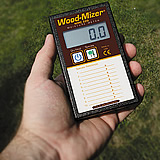I have the MT808 from Electrophysics. Has temp and species correction built in.
http://www.electrophysics.on.ca
I prefer the pin type because it can be used to measure the moisture content of wood in a DH kiln as it is drying, without having to open up the kiln. Hammer in a pair of small nails into the board the same distance apart as the meter's pins, run a wire from each nail out of the kiln, then simply connect the meter's pins to the outside ends of the wire whenever you want to test the moisture. Alligator clips are very handy. You can put pairs of nails in several boards and run several pairs of wires out if you wish.
It does give a good relative indication of how the moisture declines over time in the kiln, and also when the boards are at equilibrium.
It is true that it will leave the pin holes. I normally try to locate these close to an end/edge or some defect that will be cut away anyhow. And you don't need to test the moisture of every board in a stack. It's not a problem for the most part if you don't go pushing it into boards willy-nilly.
I've also heard that these meters are not very accurate at higher moisture levels. But I'm struggling a bit to imagine a scenario where it matters very much if the wood is at 40% or 60% MC?? In either case it's soaking and still a long ways from being ready to use! I guess if you are using a species specific kiln schedule with a wet bulb thermometer you might care.
I agree that it's important to know if the wood is at 7% or 12% because at 7% I'd use it in the shop but at 12% would wait for it to dry more or throw it in the kiln if I was in a hurry. Even the difference between 15% or 20% is not that important because is still can't be used - too wet.
Hope that helps.
Dan



























































